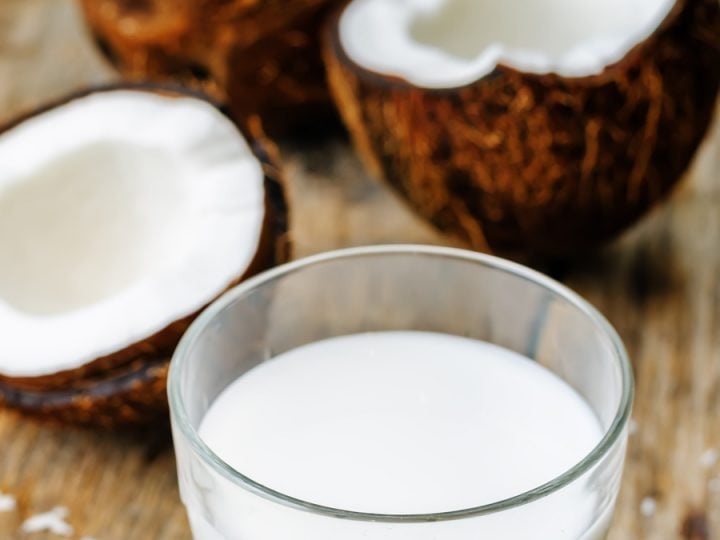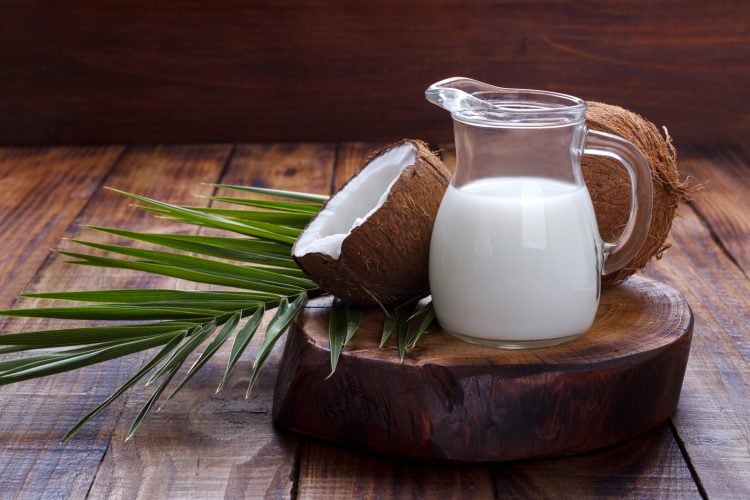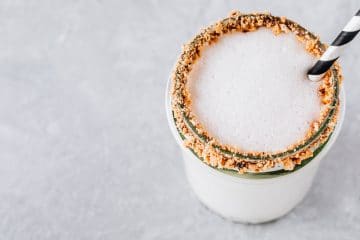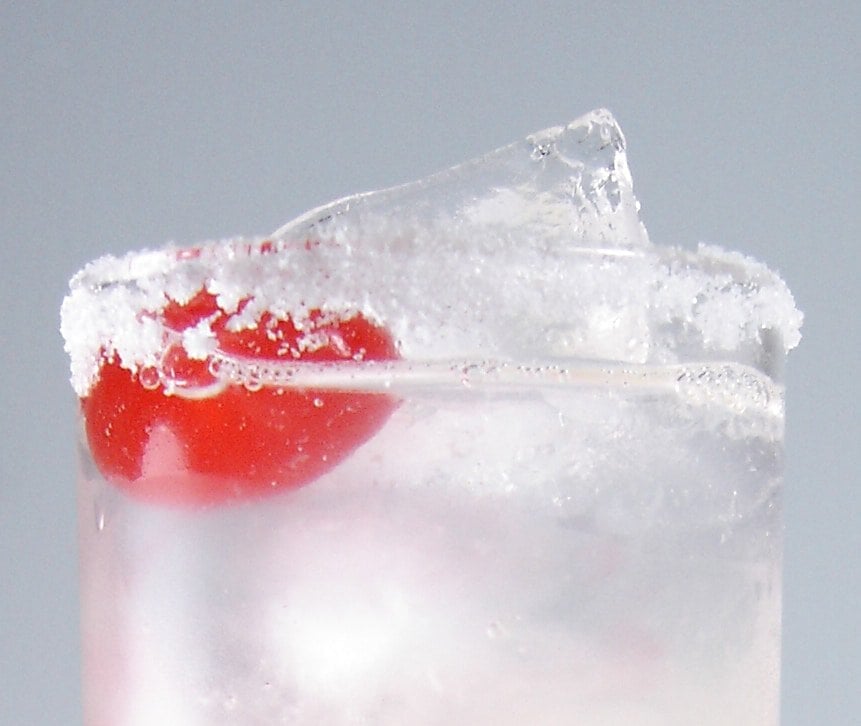If you want a good Piña Colada, you need good creme of coconut. The reigning champ of the commercial products is Coco Lopez, though it is becoming harder to find in countries outside of the US. There are a plethora of competing products on the market, but the problem is that most of these products have an artificial coconut aroma that is more reminiscent of suntan lotion than fresh coconut.
An easy solution to this problem is to make your own Coco Lopez substitute that is as easy to prepare as simple syrup; it tastes better, with no artificial additives, and if you own a bar, the cost per ounce is about a third of the commercial product.
Though tiki guru and owner of Latitude 29, Jeff “Beachbum” Berry has been quoted as saying Coco Lopez is the “best creme of coconut for cocktails,” I suspect he may change his mind after I send him this DIY recipe.
The first step is to reverse engineer the recipe by getting some clues from the ingredient list and nutrition label. Here are the ingredients from a can of Coco Lopez: Coconut, sugar, water, Polysorbate 60, sorbitan monostearate, salt, propylene glycol alginate, mono and diglycerides, citric acid, guar gum, locust bean gum.
The nutrition label indicates the following per 28-gram serving: 18 grams of sugar, 5 grams of fat and 15 mg of sodium. This tells us that we should aim for roughly 18 grams of sugar per ounce (28g).
Next, we need to assemble our ingredients, and we’ll need three. Coconut milk, sugar and salt, and that is it. We can skip all the additives like the emulsifiers, stabilizers and growth-inhibiting agents because our creme of coconut won’t be sitting on a shelf for years. For the coconut milk, you want the full-fat variety—sometimes called coconut cream, confusing yes—no diet or low-calorie stuff. Though if you’re going to try to make a low-calorie version, do it, as it might be great. I’ve had good results with Aroy-D, Gace and Thai Kitchen brands, but any quality coconut cream will do. If you are not sure which one to buy, look at the nutrition label and pick the one with the highest fat content. It can range from 5% to 32%.
I’ve done the experimenting already, with a little math based on the label and came to the following starting point. As usual with all my recipes, there is plenty of room for further experimentation. Please feel free to adjust to meet your needs.
400 ml (1 can) coconut cream
375 grams (1¾ cups) sugar
½ g Salt (⅛ teaspoon)
Danger: Cream of Coconut Math Ahead
Please feel free to skip this math-heavy paragraph and go straight to the next section, but if you are curious about reverse engineering recipes, check it out. To prove this recipe is roughly 18 grams of sugar per serving, dissolve the sugar in the milk/cream and measure the total volume (my result: 600 mL), and then you take the mass of sugar added (375 grams) and divide that by the total volume number (600 ml). This gives us 0.625 g/mL, which is the number of grams of sugar in a millilitre (mL) of our sugar/coconut mix. According to the label, the serving size is 28 grams, but they also state that 2 tablespoons are a single serving, though the two measures won’t be equal. If you weigh 28 grams of creme of coconut, it would have a volume of less than 2 tablespoons because of density. But, if we just use volume, we can take 2 tablespoons, which equals 1 oz, which equals roughly 28 mL (country dependent) and multiply that by our 0.625 grams of sugar per mL, and we get 17.5 grams of sugar per serving—close enough for our purpose. We can do the same calculation for the fat content, but I’ll spare you the details. Suffice it to say, the numbers are similar if you have ever asked, “How do you calculate a nutrition label?” this is how.
–Math Over–
The results of the calculations put us pretty much into a 1:1 cream to sugar ratio, which isn’t all that surprising if you’ve worked with simple syrup. Now that we’ve come to a close recipe, we can do any modifications we please. I add a tablespoon of Grace unsweetened coconut powder to the mixture. This addition gives a delightful, intense coconut flavour. But anything you want to add, you can do it. Next on my list is replacing the sugar with honey to make a coconut honey syrup or possibly adding pandan extract.
Cream of Coconut Recipe

Creme of Coconut is ridiculously easy to make and tastes better than the commercial products without any additives. What's not to like about that?
Ingredients
- 400 ml Coconut Milk (full-fat)
- 375 g Sugar (roughly 1¾ cups)
- 12 g Coconut Powder (1 Tbsp) (optional)
- ½ g Salt (⅛ teaspoon)
Instructions
- Combine all the ingredients into a pot and gently heat and stir until the sugar is dissolved.
- If using coconut powder, use a stick blender to blend the mixture smooth.
- Pour into a squeeze bottle for convenience
Notes
This recipe is as easy as it gets and you end up making an additive-free Coco-Lopez substitute perfect for a Pina Colada. I recommend using coconut milk with a fat content above 15%.
The serving size is 28 grams but the serving volume is 22 mL (¾ oz).
Nutrition Information:
Yield:
24Serving Size:
28 gramsAmount Per Serving: Calories: 95Total Fat: 4gSaturated Fat: 3gTrans Fat: 0gUnsaturated Fat: 0gCholesterol: 0mgSodium: 12mgCarbohydrates: 16gFiber: 0gSugar: 16gProtein: 0g
DIY Cream of Coconut Bar Pour Costs
If you run a bar, the pour cost for this version can be quite low. A single batch makes 24 servings; the input costs are $0.25 for sugar and roughly $1.29 for the coconut milk/cream, though I’ve seen it as low as $0.69 per 400 mL (14 oz) can. That puts the costs at $1.54, so each serving is 6.5 cents. Coco Lopez is roughly 24 cents per serving which means a bar can save 17.5¢ per drink. If you serve 300 Pina Colada’s or Painkillers per week, by the end of the year, you have just saved $2,730. There may even be environmental benefits (fewer metal cans, less weight shipped, etc.) though I’d need to look into it further. Suffice it say; you can make a better product for less.
Deconstructed Pina Colada Dessert
If you want to serve a Deconstructed Pina Colada, plate some freshly cut pineapple wedges with the coconut cream dip and a tasting glass of fine rum.
FAQ: What is the difference between coconut cream and coconut milk?
According to the Codex Standards for Aqueous coconut products (CODEX STAN 240-2003), coconut milk should contain at least 10% fat, and for coconut cream, it should contain at least 20%. Though, I’ve found with labelling on the cans that some coconut milk could qualify as coconut cream. The best thing to do is just read the nutrition label, and anything over 20% fat would be cream.
Further Reading: Pina Colada





